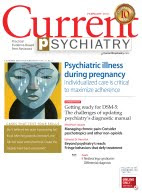Bryan K. Tolliver, MD, PhD, Assistant professor, Clinical neuroscience division, Department of psychiatry and behavioral sciences, Medical University of South Carolina, Charleston, SC
The high prevalence of substance use disorders (SUDs) in persons with bipolar disorder (BD) is well documented. Up to 60% of bipolar patients develop an SUD at some point in their lives. Alcohol use disorders are particularly common among BD patients, with a lifetime prevalence of roughly 50%. Recent epidemiologic data indicate that 38% of persons with bipolar I disorder and 19% of those with bipolar II disorder meet criteria for alcohol dependence. Comorbid SUDs in patients with BD are associated with:
- poor treatment compliance
- longer and more frequent mood episodes
- more mixed episodes
- more hospitalizations
- more frequent suicide attempts.
Read full text (free access)
Comment on this article
Email the editor


